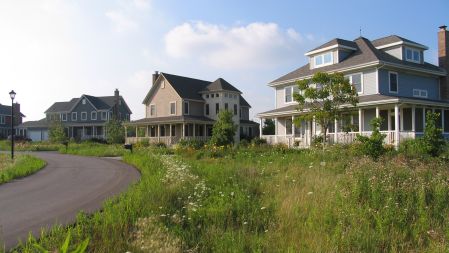Conservation Subdivision Design

Conservation subdivision design (CSD) entails a broad range of design principles and parameters that collectively enhance environmental quality, the aesthetics and quality-of-life of residents in the subdivision, and the profitability of the development for the developer. Conservation subdivisions generally reflect a condensing of developed lots on a property to protect environmentally sensitive, agriculturally valuable, or aesthetically/culturally important areas. In the process of condensing lot sizes (lot number may actually increase), lot areas that are often difficult and expensive to build on can be avoided, open space and habitat can be saved, and less infrastructure is required.
CSD Benefits
- Enhanced stormwater management. CSD protects water quality and manages water quantity by slowing and filtering stormwater runoff through wetlands, biodetention facilities, and best management practices that maximize soil water infiltration and percolation.
- Visual access to open space. Views of open space and nature have been shown to be an important amenity for homebuyers shopping in new developments; CSD typically provides access to natural vistas as an added value to residents.
- Enhanced/protected wildlife habitat . Sensitive site development that minimizes disturbances to streams, steep slopes and sensitive vegetation provides increased opportunities to maintain and enhance habitat.
- Reduced infrastructure construction costs (streets, sewers, etc.). Smaller, sensitively-placed lots require less total land coverage, thereby requiring shorter lengths of utilities and streets to access all lots.
- Large scale land reshaping and grading can usually be avoided. Less grading means the native soil is left in place for better establishment of landscape plantings.
- Reduced maintenance costs. Maintenance is a fact of life for any development, but basic CSD principles can reduce overall costs if effectively applied. Examples include less maintenance for narrower shorter streets, fewer problems with soil erosion/sedimentation as a result of sensitive site design, and lower costs associated with use of native/adapted landscape plants that can require significantly fewer inputs (labor, pesticides, etc.) than traditional plantings.
- Enhanced profit potential for land owner. Many successful CSD projects have shown that net profit per lot increases when CSD principles are appropriately applied and implemented.
Key Considerations for Conservation Subdivision Development Summary document by Steven Rodie, ASLA.*
The Conservation Subdivison Design Process Southeastern Wisconsin Regional Planning Commission
Conservation Design for Subdivisions by Randall Arendt. A highly-recommended book on the topic.
Examples and Case Studies of Conservation Subdivisions:
Information presented within the Stormwater Management section of this Water Web site has been reviewed by the University of Nebraska Stormwater Management Team. Please contact Katie Pekarek, Kelly Feehan, or Thomas Franti with questions.
Sign up for updates from UNL Water
